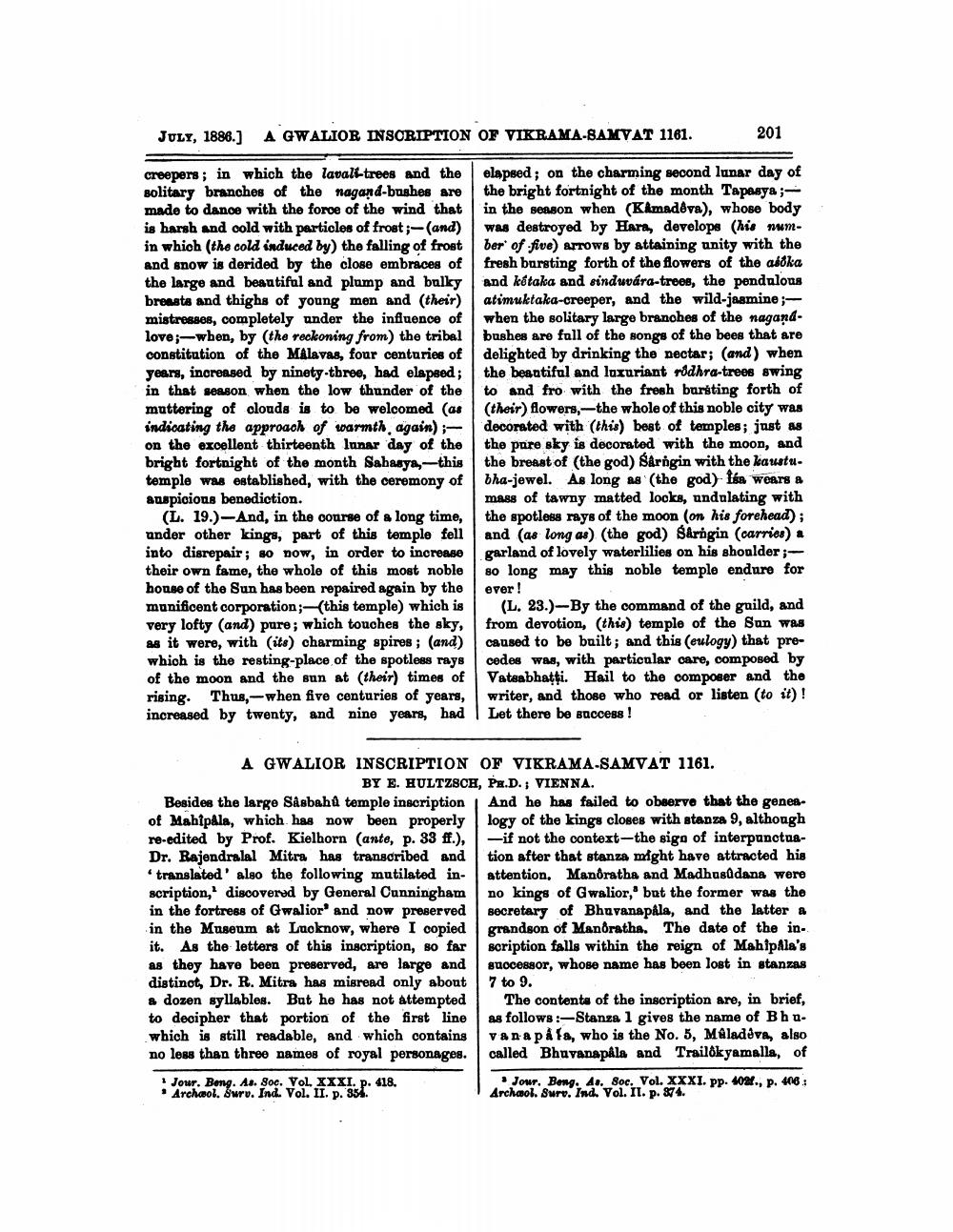________________
JULY, 1886.)
A GWALIOR INSCRIPTION OF VIKRAMA-SAMVAT 1161.
201
creepers ; in which the lavall-trees and the elapsed; on the charming second lunar day of Bolitary branches of the nagand-bushes are the bright fortnight of the month Tapasya ; made to dance with the force of the wind that in the season when (Kamadeva), whose body is harsh and cold with particles of frost; (and) was destroyed by Hara, develops (hie wnin which the cold induced by) the falling of frost ber of five) arrows by attaining unity with the and snow is derided by the close embraces of fresh bursting forth of the flowers of the aboka the large and beautiful and plump and bulky and kedtaka and sinduvára-trees, the pendulous breasts and thighs of young men and (their) atimuktaka-creeper, and the wild-jaamine; mistresses, completely under the influence of when the solitary large branches of the nagandlove ;-wben, by (the reckoning from the tribal bushes are full of the songs of the bees that are constitution of the Malavas, four centuries of delighted by drinking the nectar; (and) when years, increased by ninety-three, had elapsed; the beautiful and luxuriant nodhra-trees swing in that season when the low thunder of the to and fro with the fresh bursting forth of muttering of clouds is to be welcomed (as (their) flowers,--the whole of this noble city was indicating the approach of warmth again); decorated with (this) best of temples; just as on the excellent thirteenth lanar day of the the pare sky is decorated with the moon, and bright fortnight of the month Sabays, this the breast of the god) Barngin with the kaustutemple was established, with the ceremony of tha-jewel. As long as the god) fáa wears a auspicious benediction.
mass of tawny matted looks, undulating with (L. 19.)-And, in the course of a long time, the spotless rays of the moon (on his forehead); under other kings, part of this temple fell and (as long as) (the god) Barngin (carries) a into disrepair ; 80 now, in order to increase garland of lovely waterlilies on his shoulder; their own fame, the whole of this most noble 80 long may this noble temple endure for honse of the Sun has been repaired again by the ever! munificent corporation; (this temple) which is (L. 23.)-By the command of the guild, and very lofty (and) pure; which touches the sky, from devotion, (this) temple of the Sun was as it were, with (its) charming spires ; (and) caused to be built; and this (eulogy) that prewhich is the resting place of the spotless rays cedes was, with particular care, composed by of the moon and the sun at (their) times of Vatsabhatti. Hail to the composer and the rising. Thus, when five centuries of years, writer, and those who read or listen to it)! increased by twenty, and nine years, had | Let there be success!
A GWALIOR INSCRIPTION OF VIKRAMA-SAMVAT 1161.
BY E. HULTZSCH, PA.D.; VIENNA. Besides the large Såsbah temple inscription And he has failed to observe that the genesof Mahipala, which has now been properly logy of the kings closes with stanza 9, although re-edited by Prof. Kielhorn (ante, p. 33 ff.), -if not the context-the sigo of interpunctuaDr. Rajendralal Mitra has transcribed and tion after that stanza might have attracted his
translated also the following mutilated in- attention. Manôratha and Madhusddana were scription, discovered by General Cunningham no kings of Gwalior, but the former was the in the fortress of Gwalior and now preserved secretary of Bhavanapala, and the latter a in the Museum at Lucknow, where I copied grandson of Manôratha. The date of the init. As the letters of this inscription, so far scription falls within the reign of Mahipala's as they have been preserved, are large and guccessor, whose name has been lost in stanzas distinct, Dr. R. Mitra has misread only about
7 to 9. & dozen syllables. But he has not attempted The contents of the inscription are, in brief, to decipher that portion of the first line as follows :-Stanza 1 gives the name of Bhuwhich is still readable, and which contains vana páfa, who is the No. 5, MAladdva, also no less than three names of royal personages. called Bhavanapâla and Trailokyamalla, of
Jour. Bong. As. Soc. VOL. XXXI. p. 418. • Archeol. śwry. Ind. Vol. II. p. 354.
Jour, Beng. 41. Soc. Vol. XXXI. pp. 402., p. 400: Archaol. Suru. Ind. Vol. II. p. 374.




